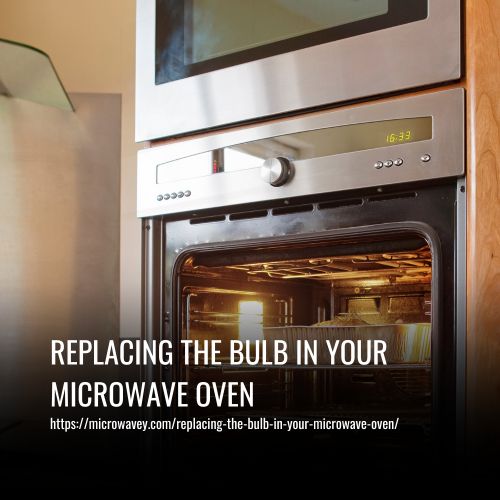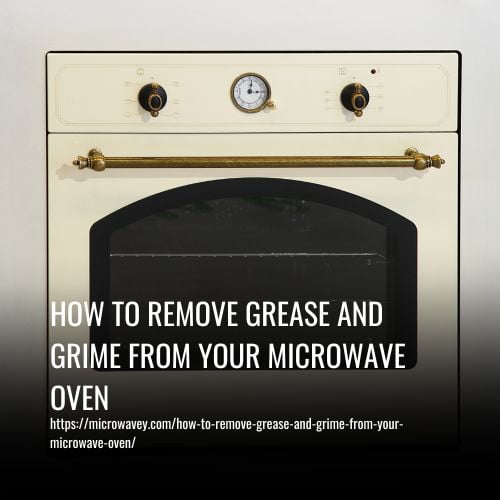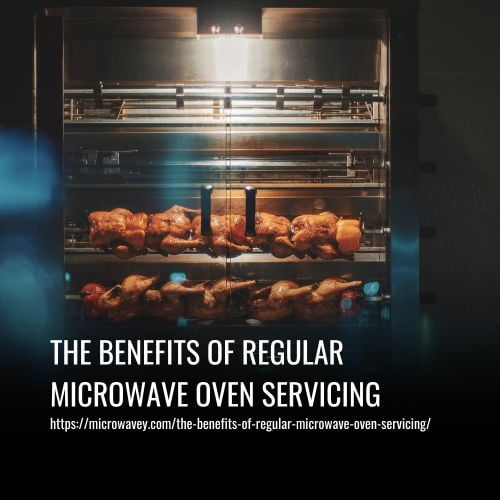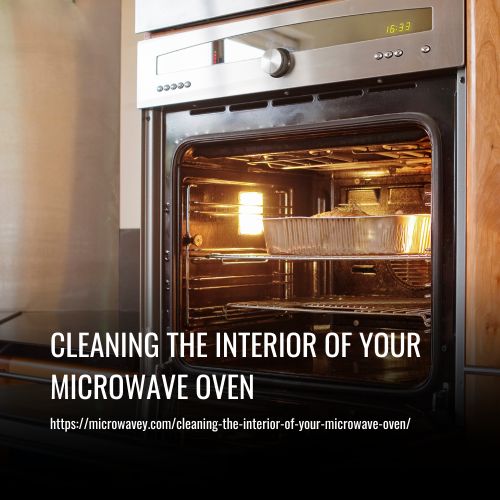How To Properly Store Your Microwave Oven When Not In Use
Cleaning your microwave thoroughly before storing will help keep it free from dust or debris that can damage its internal components over time.
Make sure you also check for any cracks or damages on the outer surface – these should always be fixed straight away otherwise they could lead to more serious problems down the line.
To Properly Store Your Microwave Oven When Not In Use, follow these Tips:
- Cleaning And Preparation.
- Inspecting For Cracks And Damage.
- Choosing The Right Location.
- Securing Your Microwave.
- Preparing For Long-Term Storage.
- Temperature Considerations.
- Humidity Considerations.
- Ventilation Considerations.
- Protecting From Unwanted Guests.
- Maintaining And Troubleshooting.
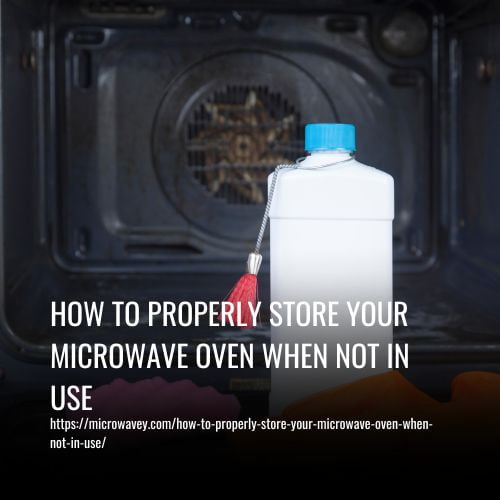
1. Cleaning And Preparation:
With regular maintenance and proper storage, your microwave will last for years! It’s time to store away that trusty microwave of yours. Before you do, there are some important steps you must take to ensure its longevity.
First off, give the unit a thorough cleaning with warm water and mild detergent; make sure not to submerge any parts or get the power cord wet. Once clean and dry, carefully inspect each part of the microwave for wear and tear or missing pieces.
Also check for loose screws or broken plastic components – these are signs that your machine might need repairs before being stored away again. Finally, wrap the power cord around itself in an orderly fashion and secure with a twist tie so it stays tangle-free until next use.
Follow these steps every time you put your microwave into storage, and I guarantee that it’ll be ready when you need it!
2. Inspecting For Cracks And Damage:
Now that your microwave oven is clean and ready to be stored, it’s important to inspect for any cracks or damage. It’s not uncommon for microwaves to get bumped around when being moved from place to place, so taking the time to make sure there’s no visible damage can help prevent further issues down the line.
Here are a few steps you should take:
- Visually inspect all sides of your microwave for any cracks or dents in the shell, glass door, and interior walls.
- Check if there are any leaks by running water into a cup and placing it inside; if steam doesn’t escape after several minutes then you’re good!
- Install insulation between the appliance and its surroundings such as walls or other appliances – this will help reduce heat transfer and protect against electrical shocks.
Taking these precautions will ensure that your microwave remains safe while in storage, which can save you from having costly repairs later on.
3. Choosing The Right Location:
Ah, the joys of storing a microwave oven! It’s like an art form – you have to ensure that your appliance is kept in its best condition and stored correctly.
When it comes to choosing the right location for your beloved machine, there are some requirements and guidelines you must meet:
| Location Requirements | Storage Guidelines | Benefits |
|---|---|---|
| Away from moisture | Clean surfaces regularly | Longevity |
| Avoid direct sunlight | Check ventilation slots | Protection from dust particles |
| No extreme temperatures | Dust-free environment | Optimal performance levels |
Following these rules will help preserve your microwave oven for years to come. Additionally, regular maintenance (such as checking/cleaning vents) will also add life to this essential kitchen tool. So next time you go looking for storage solutions, remember The advice and make sure your appliance is taken care of properly!
4. Securing Your Microwave:
When storing your microwave oven when not in use, there are a few important steps to follow.
First of all, make sure it’s thoroughly cleaned and dried before you store it away. This will prevent rust from forming or any other buildup that may occur due to lack of ventilation.
Secondly, ensure the space where you’re keeping the microwave is well-ventilated so that heat can escape as needed. If possible, try to keep it off the ground too – this will help avoid any potential water damage if something were to spill nearby.
Finally, if you’d like an extra layer of protection for your appliance then consider covering it with a cloth while not in use. This should assist in preventing dust particles from gathering on its surface and also aid in venting heat properly throughout its duration of storage.
With these tips in mind, you’ll be able to rest assured knowing your microwave oven is safe and secure!
5. Preparing For Long-Term Storage:
Now that we’ve discussed the importance of securing your microwave oven when not in use, let’s talk about preparing it for long-term storage.
Storing a microwave safely and securely is essential to ensure its longevity; however, costs can vary depending on how prepared you are.
First and foremost, make sure you unplug the power cord from any electrical outlets. This will help protect against potential hazards as well as keep energy bills low during periods of non-use.
Additionally, it may be beneficial to consider investing in a protective cover or bag to store your appliance in between uses. Not only does this prevent dust build up but it also helps maintain the quality of the outside casing over time – saving you money on costly repairs down the line!
6. Temperature Considerations:
When storing a microwave oven, it is important to remember that the appliance still radiates heat even in its dormant state. It’s like a sleeping dragon, ready to awaken and do your bidding at the flick of a switch or adjusting of power settings.
This means that when deciding where to store your microwave you must take into account how much space there will be for proper ventilation; otherwise the heat can become trapped and cause damage to both itself and any items stored around it.
The best place for storage depends on the type of environment you have – if you have more room then consider putting it up high off the ground so air can circulate underneath, but if space is limited try finding an area with plenty of open space surrounding it.
In either case, avoid leaving anything combustible too close as this could start fires due to built-up heat emanating from within. With these considerations in mind, happy cooking!
7. Humidity Considerations:
When storing your microwave oven when not in use, it’s important to consider both waterproofing and dustproofing. Waterproofing will protect the interior components from potential water damage, while dustproofing helps keep dirt and debris out of the appliance.
I recommend keeping the oven stored in a dry place with adequate ventilation, such as a garage or shed. If you’re able to find an area that is also protected from direct sunlight, this can help further reduce the risk of any moisture build up inside the unit.
It’s also a good idea to cover your microwave with some kind of cloth material for added protection against dust and dirt particles. Following these simple steps will ensure that your microwave remains in perfect working condition for years to come!
8. Ventilation Considerations:
Now that we’ve discussed the importance of keeping your microwave oven in a humidity-controlled environment, let’s turn our attention to ventilation considerations.
It may seem counterintuitive, but proper ventilation is crucial for preserving and protecting any electrical appliance. Without adequate air flow, you run the risk of overheating the components inside your microwave oven which can lead to permanent damage over time.
So what does good ventilation look like? The best way to ensure proper air flow around your microwave oven is to leave at least 3 inches (7 cm) of space between it and other objects when storing or using it.
Additionally, make sure no items are blocking any vents on the sides or back of the appliance. If you have an older model with exhaust fans, these should be checked regularly for dirt buildup and debris as this can also impede airflow and cause damage.
With some careful planning and regular maintenance, your microwave oven will remain safe and reliable while it waits patiently until its next use!
9. Protecting From Unwanted Guests:
As an expert in microwave oven storage, I strongly recommend that you take the extra steps to make sure your appliance is protected from unwanted guests. Pest-proofing and rodent-proofing can help keep critters out of your kitchen cupboard or wherever else you plan on storing it.
Here are a few tips for pest proofing:
- Make sure any food products stored with the oven are sealed tightly in airtight containers or bags.
- Regularly check the exterior of the oven for signs of pest activity such as droppings or gnaw marks.
- Place bait traps near where you store the oven to catch potential pests before they enter your home.
These simple steps will help ensure that no unexpected visitors show up when you least expect it! With these tips, you’ll have peace of mind knowing that your device is safe from harm while not in use.
10. Maintaining And Troubleshooting:
Now that you’ve taken the necessary steps to deter unwanted guests, it’s time to focus on maintaining and troubleshooting your microwave oven.
Taking a few preventative measures can save you from power issues or any other problems in the future. Make sure to unplug your device when not in use as this helps ensure proper functioning.
Furthermore, depending on where you are storing it, noise control may be something you want to consider. If possible, place a thick blanket over your device; this will help reduce some of the sound levels coming from the appliance.
Regularly check for dust buildup inside and outside the unit too; if there is an excess amount present, make sure to clean it out with a damp cloth before using again.
With these simple but effective tips, your microwave should stay in tip-top shape!
FAQs
When it comes to storing your microwave oven when not in use, cleaning frequency and ventilation needs should be checked regularly for cracks or damage. As an expert on proper storage of microwave ovens, I recommend inspecting the appliance every few months or so. This is especially important if you’re storing your oven in a confined space with limited air circulation – this can cause overheating and further problems down the line.
Make sure that all vents are clear from any dust buildup as well; if needed, give them a light clean using compressed air. It’s also a good idea to check for any signs of wear-and-tear such as loose screws or broken parts. Taking these simple steps will help ensure that your microwave oven stays in peak condition while stored away!
Storing a microwave oven in the long-term can be tricky, but with some expert advice it doesn’t have to feel like an uphill climb. To prevent mold and avoid moisture build up, experts recommend keeping your appliance in a clean and dry environment – think of it like storing away a beloved family heirloom!
Make sure that you find a storage facility that has climate control (ideally one with temperature regulation) so as to protect against any unexpected environmental changes and keep your microwave oven looking as good as new for years to come.
When storing your microwave oven in the long-term, it’s important to consider temperature. The optimum temperature for storage is 50 degrees Fahrenheit or lower.
This will help reduce power consumption and ensure that no cleaning techniques are necessary when you retrieve it. Keeping your microwave at this temperature will also prevent any damage to the internal components of the appliance.
As an expert on microwave oven storage, I recommend taking preventative measures to ensure your appliance is protected from pests. Pest proofing and air tightness are key components when it comes to keeping unwanted visitors away from your microwave oven while storing it long-term.
Consider using plastic wrap or aluminum foil to cover the door tightly and use a dryer sheet inside the cavity for added protection. Additionally, be sure to store your microwave in a cool and dry location out of direct sunlight for optimal results.
If your microwave oven isn’t working properly, there are a few troubleshooting tips you can follow. First, check the plug and cord for any signs of damage or fraying – if so, then it’s time to replace them before attempting to use the microwave again.
If that doesn’t solve the issue, you’ll need to look deeper into what might be wrong with it. Make sure all settings are correct as well as checking for any faulty parts like switches or fuses. Finally, if none of these options work, it may be best to seek professional help from an appliance repair service.
When transporting or storing your microwave oven when not in use, make sure it is secured safely inside a box and wrapped in padding material to protect its exterior from dust, dirt and moisture buildup.
Conclusion
Storing your microwave oven when not in use is an important step to ensure its longevity. Although it might seem like a daunting task, following these simple steps will help make sure you get the best results out of your appliance and keep it running for years to come.
First, be sure to check regularly for cracks or other damage that could have occurred during transport or storage. Inspecting your microwave oven every few months will give you peace of mind knowing that it’s in good condition and ready for use.
Secondly, find a temperature-controlled environment away from direct sunlight or extreme temperatures whenever possible. This helps prevent any issues with components such as motors that may cause unexpected problems down the line.

